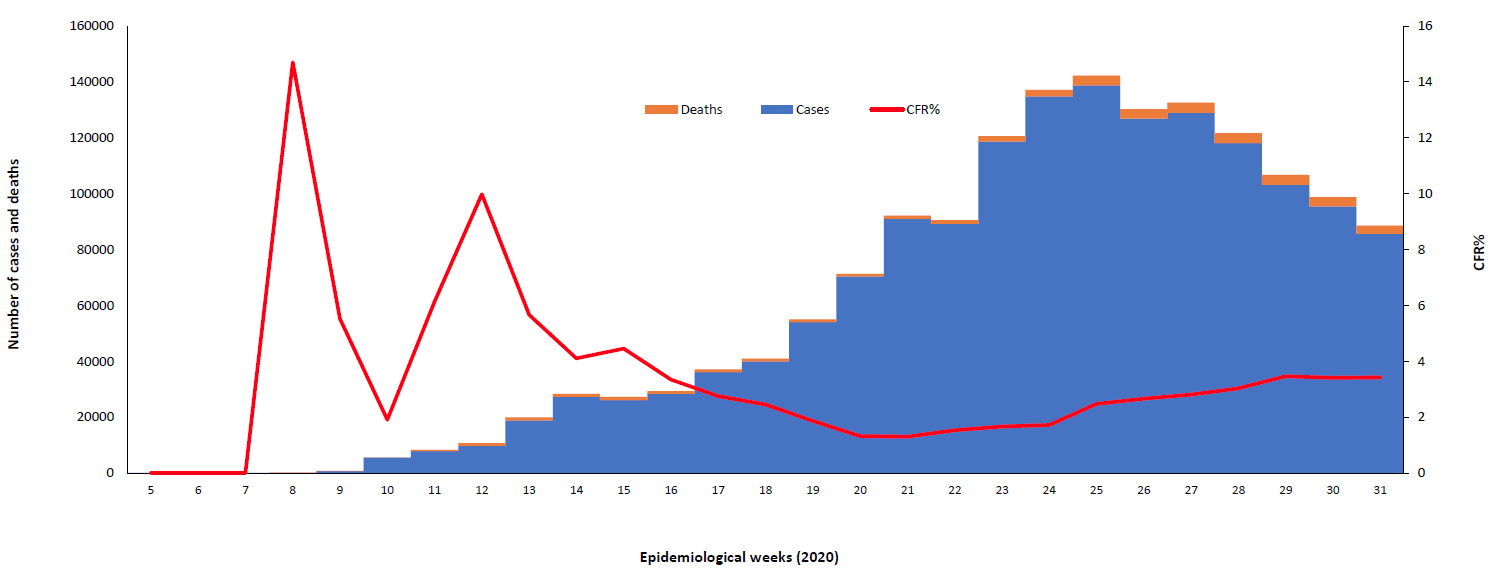Coronavirus disease 2019 (COVID-19) has been spreading for the past 6 months, and it continues to accelerate at regional and global levels. As of 1 August 2020, 17 396 943 cases and 675 060 associated deaths with a case-fatality rate (CFR) of 3.9% have been reported globally. During week 31, the highest daily incidences to date were reported on 31 July and 1 August, with 292 527 and 289 321 new cases, respectively. The 22 countries of the Eastern Mediterranean Region (EMR) have reported a total of 1 555 459 cases so far, which represent about 8.9% of the global count, with 40 410 associated deaths (CFR 2.6%). Most countries in the Region are in the community transmission phase.
Since the beginning of the outbreak, the country that has reported the highest number of total cases in the Region is Islamic Republic of Iran (306 752 cases; 19.7% of the Region’s total), followed by Pakistan (279 699; 18.0%) and Saudi Arabia (277 478; 17.8%). Islamic Republic of Iran also reported the highest number of total associated deaths (16 982; CFR 5.5%) followed by Pakistan (5976; CFR 2.1%) and Egypt (4834; CFR 5.1%). The highest CFR was reported from Yemen (28.5%) followed by Sudan (6.4%), while the lowest CFR was reported from Qatar (0.2%) followed by Bahrain (0.4%).
During epidemiological week 31, the Region reported a 10.3% decrease when compared to the cases reported during the previous week (85 636 cases compared to 95 476 cases). A 10.1% reduction was observed for associated deaths as well (2928 deaths compared to 3256 deaths). On the other hand, the weekly trend per capita showed stabilization as compared to the previous week (212.8/100 000 compared to 201.3/100 000).
In week 31, Morocco, Lebanon and Jorden reported an increase in COVID-19 activity. The number of cases in Morocco increased from 19 645 to 25 051 (a 28% increase compared to 15% during the previous week), with 77% of cases this week reported from three regions (28% from Casa Settat, 25% from Fès meknes and 24% from Tanger Tetouan Al Hoceima). Deaths in Morocco increased from 305 to 367 (20% increase compared to 13% in previous week). Cases in Lebanon increased from 3582 to 4730 (32% increase compared to 29% in previous week), with 54% of cases this week reported from three regions (36% from Mount Lebanon, 12% from Beirut and 6% from Baalbeck-Hermel). Deaths in Lebanon increased from 47 to 61 (30% increase compared to 18% in previous week)
In terms of testing, a total of 19 357 211 laboratory PCR tests were conducted since the start of the outbreak across the Region including 1 600 662 tests in week 31, which is approximately the same number of tests performed in the previous week (1 602 013). The highest number of PCR tests were reported from United Arab Emirates (5.1 million), followed by Saudi Arabia (3.4 million) and Islamic Republic of Iran (2.5 million). The United Arab Emirates and Bahrain are performing the highest rate of testing per capita (51 764/100 000 and 491 056/100 000 respectively). The average positivity rate for the Region is 8%. WHO recommends a positivity rate of around 3–12% as a general benchmark indicating adequate testing, which was achieved in most countries of the Region.
The regional incident management support team continues to coordinate the response and provide technical support to countries and partners in the Region in the areas of coordination and partnership, surveillance, laboratory capacity, clinical management, infection prevention and control, risk communication, points of entry according to the International Health Regulations (IHR 2005), research, health system, essential health services and others. Capacity building activities continued with the delivery of training workshops in collaboration with WHO collaborating centers. These covered infection prevention and control (IPC) for Saudi Arabia, online training of trainers for IPC practitioners in Iraq, and RT-PCR testing for SARS-CoV-2 in north and east Syria.
WHO, UNFPA and UNICEF conducted a joint virtual meeting for the preparation of a virtual meeting with regional directors and ministers of health on the continuation of essential reproductive, maternal, neonatal, child, and adolescent health care services in the context of COVID-19. A tailored clinical management training package was also developed with Jordan and Afghanistan, while a COVID-19 awareness-raising campaign was conducted in Baghdad.
WHO has also developed and disseminated technical documents to help guide countries’ strategies and policies to manage the pandemic. WHO has updated the interim guidance on water, sanitation, hygiene, and waste management for SARS-CoV-2, the virus that causes COVID-19. It also released interim guidance on safe Eid al Adha practices in the context of COVID-19. Regarding operational support and logistics, over all, 636 purchase orders have been processed by the Dubai hub since February at a value of USD 50 142 475.
Finally, the fourth meeting of the International Health Regulations (2005) Emergency Committee regarding the outbreak of coronavirus disease (COVID-19) was convened by the WHO Director-General on 31 July 2020. On advise of the Emergency Committee, the Director-General declared that the outbreak of COVID-19 continues to constitute a public health emergency of international concern (PHEIC). Recommendations from the Emergency Committee highlight the need for response efforts to continue over the long term.

For more data from the Region, please visit the COVID-19 dashboard.
Subscribe to the monthly infectious hazard preparedness newsletter of WHO’s Health Emergencies Programme for latest data and analysis on epidemic- and pandemic-prone diseases, as well as news on outbreak preparedness and response within WHO’s Eastern Mediterranean Region.




